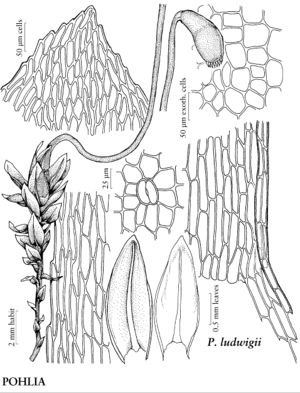Pohlia ludwigii
Acta Soc. Sci. Fenn. 19(12): 27. 1892.
Plants medium-sized to large, green, sometimes red tinged, dull. Stems 0.8–3.5 cm. Leaves erect to ± spreading, lanceolate to broadly lanceolate, 1.2–2.4 mm; base long-decurrent; margins serrulate to serrate in distal 1/3; costa subpercurrent; distal medial laminal cells rhombic to rhomboidal, 40–80 µm, walls firm to thin. Specialized asexual reproduction absent. Sexual condition dioicous; perigonial leaves broadly short-ovate; perichaetial leaves scarcely differentiated, broadly lanceolate. Seta orangebrown. Capsule inclined 90–180°, brown to stramineous, broadly pyriform, neck 1/3 urn length; exothecial cells short-rectangular, walls weakly to moderately sinuate; stomata superficial; annulus present; operculum bluntly conic; exostome teeth yellow to brown, triangular-acute; endostome hyaline, basal membrane to 1/2 exostome length, segments tapered apically, distinctly keeled, broadly perforate, cilia short to long. Spores 14–21 µm, finely roughened.
Phenology: Capsules mature summer (Jun–Aug).
Habitat: Soil, late snowmelt areas in alpine and subalpine zones
Elevation: high elevations
Distribution

B.C., N.W.T., Ont., Que., Alaska, Ariz., Colo., Idaho, Mont., Wash., Eurasia
Discussion
Pohlia ludwigii is a rare alpine species, often found in habitats similar to those of P. obtusifolia and characterized by strongly decurrent leaves that are often slightly cucullate apically. The older lower leaves generally have a pink to reddish tinge. The leaf apices are acute to bluntly acute; the endostome segments are papillose; and the perichaetial leaf costae are very strong at their bases. In late snowmelt areas, P. ludwigii can form deep cushions when sterile.
Selected References
None.
Lower Taxa
"tapered" is not a number."narrow" is not a number.
